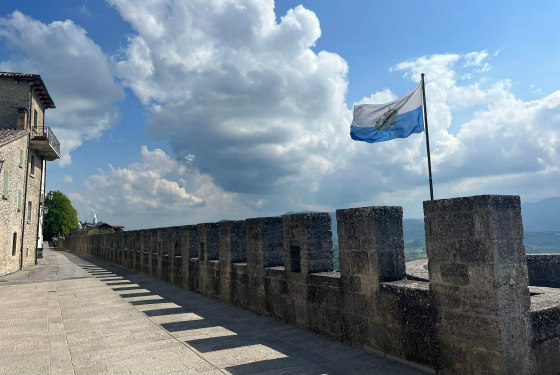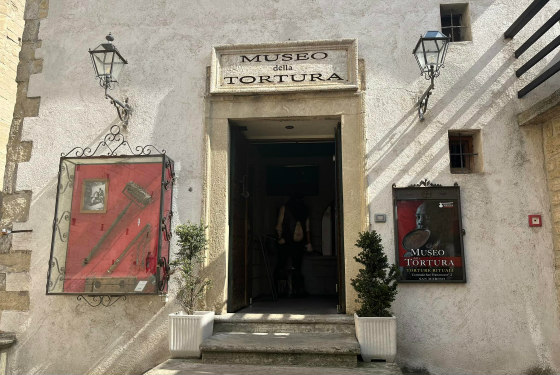Nestled away high on the slopes of Mount Titano in Central Italy, San Marino is one of the oldest and smallest independent countries in Europe. It is also often listed among continent’s least-visited countries, a reputation that the local government is working hard to turn around.
To this end, the Eurovision Song Contest has been a useful outlet for San Marino to raise their profile on the world stage – which may well explain why they’ve stuck around long after many other so-called ‘micro states’ gave up. With their neighbours in Italy hosting this year, I took the opportunity to pay a visit to discover first-hand what the Most Serene Republic has to offer…
Getting to San Marino
The first challenge to exploring San Marino is getting there! Historians believe that they managed to maintain their independence for over 1600 years largely because they were so difficult to get to! The main city is essentially a medieval fortress perched in the heights of the mountain, surrounded by forbidding stone walls.
From my base of operations in Turin, I took a train to the beach resort city of Rimini. From there, a regular bus service runs to and from the town centre to Città di San Marino. It only costs €5 each way, with a journey length around 40 minutes. On the way you pass through San Marino’s lower-lying towns such as Dogana and Borgo Maggiore, before a long climb up the mountainside to the old town.

San Marino (photo: John Lucas)
Where to stay
Given its size, many tourists restrict their time in San Marino to a day trip. While it’s certainly possible to hit all the essential spots in one day, you can also choose from a handful of mid-priced hotels. Personally, I loved the evenings in the old town – after the majority of tourists head home the cobbled streets become beautifully, eerily quiet. Plus watching the sunrise over the incredible skyline is an absolute must.
A note of caution – if you do choose to stay the night, make sure you’re in Città di San Marino, as the buses generally stop running in the early evening, and it’s rather difficult to access by foot from the lower towns. (Borgo Maggiore is a walkable distance, Dogana considerably less so). I stayed at the Hotel La Grotta, which was perfectly located at the heart of the old town shopping and restaurant district.
What to do
Conveniently enough, most of San Marino’s must-see attractions can be found in Città di San Marino. Top of anybody’s list should be a visit to the three towers that triangulate the city – Guaita, Cesta and Montala. Guaita is the largest and is also open to the public. Climbing to the very top is a little intimidating, but well worth it for some of the most breathtaking views you’ll ever see.
Another great viewing spot is the Piazza della Liberta, where you can visit San Marino’s seat of government and occasionally watch the ceremonial changing of the guards. Just around the corner from this, you can also grab the Funivia cable car down to Borgo Maggiore for more spectacular views, not to mention the chance to visit a charming little town in its own right. Stop by at the Time Off bar to grab some lunch, and if your legs can take it, you can walk back up to Città di San Marino via a lovely, but steep, mini-nature trail.
Aside from sightseeing, San Marino also packs its tiny centre with a surprising number of miniature museums. There’s the State Museum, featuring a fascinating potted history of the country, and the Gallery of Modern and Contemporary Art. Aside from those, for some reason you can also visit a Museum of Torture, a Museum of Curiosities and a Museum of Vampires and Werewolves! It seems the Serene Republic has a dark side!

San Marino’s Museum of Torture (photo: John Lucas)
Where To Eat
With an economy driven on tourism, San Marino has no shortage of shops and restaurants to choose from. Cuisine naturally leans Italian, although you can also sample some traditional Sammarinese dishes including locally harvested Pigeon and Venison dishes, plus their very own line of red wine.
I enjoyed a glorious three-course meal at La Terrazza, which offered an intimate dining experience accompanied by more of those unforgettable San Marino views!
Quickfire trivia
- There are no border controls between Italy and San Marino, but for a small fee, you can get your passport stamped at the Office of Tourism.
- One slightly unnerving aspect of the town centre is the proliferation of shops selling firearms. San Marino apparently has very relaxed rules in this regard.
- Another cool feature – several of the tourist information boards on the main plaza are provided in both English and Italian braille! We love to see an accessible microstate!

San Marino’s Valentina Monetta (photo: EBU/Eurovision.tv)
San Marino’s Eurovision journey
San Marino debuted in the Contest in 2008, but withdrew the following year after Miodio’s failure to qualify. Since 2011, they have competed consistently each year. They finally scored their first qualifier in 2014 with Maybe, their third consecutive entry to be performed by Valentina Monetta. They reached the finals again in 2019 with Say Na Na Na by Serhat, and yet again in 2021 with Senhit and Flo Rida.
Where other small countries such as Andorra, Luxembourg and Monaco have long-since fallen away, San Marino have shown impressive resilience, taking a variety of approaches to leverage their international connections, provide a platform for local talent and keep their annual participation costs manageable.
This year, Achille Lauro will become the sixth Italian artist to represent the microstate, reflecting the strong cultural links between the two nations. Senhit (2011, 2021) was born in nearby Bologna, Michele Perniola (2015) hails from the southern town of Palagiano, and Miodio (2008) also comprises of three Italians alongside two members from San Marino.
Lauro is the first San Marino representative to have also performed at Italy’s San Remo festival the same year. With a high local profile and extensive stage experience, he’s likely to bring RTV another strong showing – guaranteeing more exposure for a country that seldom finds itself represented on pan European primetime TV. Don’t be surprised to see more San Remo stars courted by their resourceful neighbours in future Contests…









